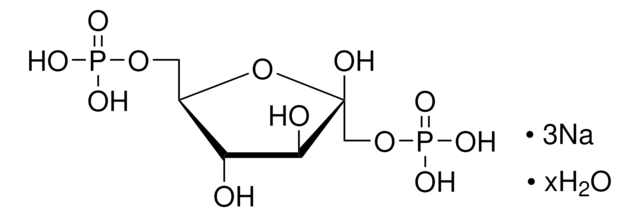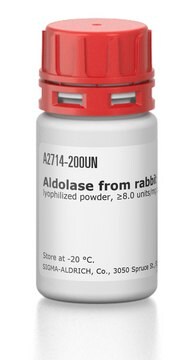推荐产品
产品名称
Hymeglusin, ≥98% (HPLC), from Fusarium sp.
生物源
Fusarium sp.
品質等級
化驗
≥98% (HPLC)
形狀
powder
溶解度
DMSO: soluble
H2O: insoluble
acetone: soluble
chloroform: soluble
ethyl acetate: soluble
儲存溫度
−20°C
InChI
1S/C18H28O5/c1-12(8-13(2)9-14(3)10-17(20)21)6-4-5-7-16-15(11-19)18(22)23-16/h9-10,12,15-16,19H,4-8,11H2,1-3H3,(H,20,21)/b13-9+,14-10+/t12-,15-,16-/m1/s1
InChI 密鑰
ODCZJZWSXPVLAW-KXCGKLMDSA-N
生化/生理作用
Hymeglusin is a specific β lactone inhibitor of eukaryotic hydroxymethylglutaryl-CoA synthase (HMGCS), a key enzyme in the cholesterol biosynthetic pathway. Unlike other fungal metabolites, Hymeglusin inhibits mevalonate biosynthesis by acting on HMG-CoA synthase, while other fungal metabolites such as Lovastatin (Mevinolin) and Compactin act as specific competitive inhibitors of the HMG-CoA reductase. Inhibition results from covalent modification of the active Cys129 residue by the enzyme by the formation of a thioester adduct in the active site. Hymeglusin show no inhibitory effect against fatty acid synthetase purified from Sacharomyces serevisiae. Hymeglusin was found to block the growth of Enterococcus faecalis. After removal of the inhibitor from the culture medium, a growth curve inflection point is observed. Upon Hymeglusin inactivation, enzyme activity is restored at a rate that is 8-fold faster for human HMGCS than for the bacterial enzyme (mvaS). Structural studies explain these differences. Hymeglusin was also found to inhibit the replication of the dengue live virus (DEN-2 NGC virus) in K562 cells. Lovastatin inhibits DEN-2 NGC live virus replication in human peripheral blood mononuclear cells.
準備報告
A DMSO solution (1 mg/mL) is stable for one month at −20 °C.
儲存類別代碼
11 - Combustible Solids
水污染物質分類(WGK)
WGK 3
閃點(°F)
Not applicable
閃點(°C)
Not applicable
H Tomoda et al.
The Kitasato archives of experimental medicine, 65 Suppl, 1-12 (1993-04-01)
Thiotetromycin is isolated from Streptomyces sp. OM-674 discovered in the course of the screening for antibacterial antibiotics. The antibiotic was found to be a specific inhibitor of type II fatty acid synthase. In order to search acyl-CoA synthetase inhibitors, a
Potent inhibitory effect of antibiotic 1233A on cholesterol biosynthesis which specifically blocks 3-hydroxy-3-methylglutaryl coenzyme A synthase.
S Omura et al.
The Journal of antibiotics, 40(9), 1356-1357 (1987-09-01)
N Aboushadi et al.
Biochemistry, 39(1), 237-247 (2000-01-08)
We have previously identified a CHO cell line (UT2 cells) that expresses only one 3-hydroxy-3-methylglutaryl coenzyme A (HMG-CoA) reductase protein which is localized exclusively in peroxisomes [Engfelt, H.W., Shackelford, J.E., Aboushadi, N., Jessani, N., Masuda, K., Paton, V.G., Keller, G.A.
Dinesh A Nagegowda et al.
The Biochemical journal, 383(Pt. 3), 517-527 (2004-07-06)
3-hydroxy-3-methylglutaryl (HMG)-CoA synthase (HMGS; EC 2.3.3.10) is the second enzyme in the cytoplasmic mevalonate pathway of isoprenoid biosynthesis, and catalyses the condensation of acetyl-CoA with acetoacetyl-CoA (AcAc-CoA) to yield S-HMG-CoA. In this study, we have first characterized in detail a
M D Giron et al.
Archives of biochemistry and biophysics, 302(1), 265-271 (1993-04-01)
Using insect (Drosophila) and rodent mammalian cell cultures we demonstrate that acute mevalonate-mediated suppression of 3-hydroxy-3-methylglutaryl coenzyme A was initiated in the absence of protein synthesis. In addition, insect and mammalian cells depleted (1 h) of putative regulatory post-isopentenyl-1-pyrophosphate metabolites
我们的科学家团队拥有各种研究领域经验,包括生命科学、材料科学、化学合成、色谱、分析及许多其他领域.
联系技术服务部门







